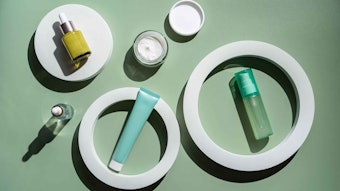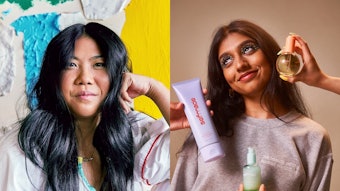Modern hair treatments have to fulfill technical requirements and high emotional demands. While data on hair combing, tensile strength or fatigue testing are common to support technical claims, the market success of a product is essentially determined by fulfilling those emotional characteristics that are claimed in the advertisement.
In hair care, these emotional aspects are determined mainly by feel and appearance. Both of these parameters are difficult to assay directly by objective methods; they must be scored by sensory assessment and can be supported by a combination of various technical investigations.
In this study, the appearance of hair tresses was evaluated by color measurements, fiber tensile strength and keratin degradation parameters. The type of damage selected for testing purposes was irradiation by ultraviolet/visible (UV/VIS) light, simulating the sun.
Materials
UV absorbers: The UV absorber investigated in this study was polysilicone-19 (PS-19), a substantive siloxane copolymer grafted with 4‑methoxycinnamic acid ester and cationic alkoylamidopropyl dimethyl ammonium groups. PS-19 is depicted graphically in Figure 1. PS-19 is based on a silicone backbone for soft feel and a silky appearance. It incorporates cationic centers for substantivity on hair and other surfaces. Finally, it includes methoxycinnamic acid residue for UV absorption. Earlier studies1 have described the principal structural features of this producta.
The substantivity on hair of PS-19 from shampoos and conditioners was proven by confocal laser scanning microscopy (CLSM).2 For this purpose a special derivative of PS-19 with a covalently bound fluorescent marker was prepared without significantly changing the molecular structure and surface interaction. The PS-19 modified with fluorescent marker was incorporated into shampoo and rinse-off conditioner test formulations (Formula 1 and Formula 2). After this treatment, single hair fibers were investigated with CLSM (Figure 2). The reflection mode of the device shows the topography of the hair fiber. The image in fluorescence mode shows the localization of the labeled material on the same fiber area. This demonstrates that the PS-19 material is substantive from a rinse-off conditioner application to hair. Similar results were received with a rinse-off shampoo application. Untreated hair, as a control, did not show a fluorescence effect.
In this study PS-19 was compared with four other commercially available cationic and neutral UV screens. These four products were selected for this study because of their claimed ability to protect the hair fiber against UV irradiation. The tested cationic UV absorbers were dimethylpabamidopropyl laurdimonium tosylate (DMPLT)b, polyquaternium-59(PQ-59)c and polyamide-2 (PA-2)d. The tested neutral silicone-based material was polysilicone-15 (PS-15), also known as diethylbenzylidene malonate dimethiconee.
The absorption spectra of all investigated materials are shown in Figure 3. The data were obtained with concentrations of 50 mg/L in ethanol. The strongest UVB absorption was observed with DMPLT. This material is a monomeric quat without a polymeric backbone; therefore it is the material with the highest density of chromophores, i.e., the absorbers of UV light at special wavelengths. Among the polymeric test products, PS-19 showed the strongest and widest absorption in the UVA and UVB range.
Hair treatments: Two types of cosmetic treatments have been applied as model systems. One was a standard shampoo (Formula 1) based on sodium laureth sulfate (SLES) and cocamidopropyl betaine (CAPB) as one surfactant system, and the other formulation was a conditioner rinse (Formula 2) based on fatty alcohol and cetrimonium chloride (CTAC). The test compounds were incorporated into these base formulations.
The evaluation was conducted using European hair. The hair tresses used in this investigation had been pretreated by a bleaching process. This pretreatment damages the hair fiber in a way that simulates the damage typically caused when consumers perm, bleach or dye the hair. For color fading tests, hair tresses were dyed using commercially available coloration kits purchased from retailers. Both permanent(level 3)f and demipermanent(level 2)g dyes were applied (see Semi-, Demi- and Permanent on Page 104.).
Red shades of hair color were chosen because they are the most likely to fade when exposed to UV.
UV/VIS-irradiation: UV/VIS irradiation was induced using a sunlight simulatorh. The sunlight simulator was used to provide light spectrum D65. Within 4 hr, this spectrum simulates the dose rate of one day of sunlight at 50° northern latitude (e.g., Frankfurt, Germany). The irradiation time between single test treatments and measurements corresponded to twice a natural daily dose. All measurements were calibrated by pairwise comparison of the values before and after irradiation.
Methods
Hair fiber tensile strength, fiber keratin integrity and hair color were measured instrumentally. Conditioning properties were subjected to a sensory assessment.
Tensile strength: The tensile strength of single hair fibers with and without UV irradiation was tested to detect damage from exposure to UV light. The hair fibers were European virgin brown hair, pre-damaged by bleaching (10% H2O2, 30 min, 22°C). The test products were incorporated into the conditioner formulation at a level of 2% active (Formula 2). As control, the same formulation was used without test material. The fibers (30 per test formula) went through four treatment cycles including: soaking in conditioner
(10 min), rinsing under tap water (6 sec, 38°C), drying (12 hr, 22°C, 50% RH) and irradiation for 7 hr.
Data of tensile strength was obtained as start and end values. The start value was the tensile strength of the pretreated fiber. The end value was the tensile strength of the fiber after four test cycles. The tensile strength value was taken as “load 15%” (mN/mm2), i.e., the force value at 15% elongation measured instrumentallyk. The value of ΔLoad is the difference before and after the treatment procedure. After measurement of the start value the hair fibers had to be relaxed by soaking in water for 2 hr.
Keratin integrity: The hair fiber keratin integrity was investigated using differential scanning calorimetry (DSC).13 This method delivers information about the degree of damage to the fiber’s keratin structure.
In the test setup, flat tresses (European human hair, single bleached) of 0.5 cm width were used. The tresses underwent four treatment cycles, including a shampooing step (0.5 g/tress for 30 sec, 1 min residence, 1 min rinsing) followed by conditioning(0.5 g/tress, 2 min residence, 2 min rinsing). In the shampoo tests the application was repeated once in each cycle without applying any conditioner. In the conditioner tests both the control shampoo and the test formulation were applied only once per cycle. Formula 1 was again used as the text formulation, and the control was Formula 1 without the test material.
After drying at room temperature, the tresses were irradiated for 4.25 hr (the dose rate of approximately one day of sunlight). To maintain homogeneous irradiation, the hair tresses were spread to single fibers. Finally the hair tips were cut to the required amount for the DSC determination. Each test product was run in triplicate.
Color measurement: Hair color was measured using a CIE-L*a*b* color metermto detect fading due to UV exposure. The color variations are expressed as integral difference, ΔE, based on changes of brightness (L*), red-green (a*) and blue-yellow (b*) shift.
Application of shampoo or rinse conditioner or both can lead to the fading of hair dye; this fading may overlie the effect of the UV/VIS light. In the case of hair that has been exposed to both treatments (i.e., shampoo and/or conditioner) and UV/VIS light, interpretation of color measurements would not be accurate. The best differentiation with good reproducibility was obtained when conducting the measurement directly before and after irradiation, without any intermediate treatment.
The selected procedure used flat-glued tresses of single-bleached European human hair, 4 g in weight, 16 cm long and 2 cm wide. The dye was applied according to the directions included with the product. Eleven tresses were treated with a single coloration. After a drying time of at least 24 hr, the tresses were treated with the test formulations (Formula 1 and Formula 2) or the control formulation (Formula 1 and Formula 2 without the test material). The tresses were dried again. The color value was determined by 12 single measurements of the CIE-L*a*b* color values on one tress. An irradiation period of 7 hr was chosen to apply a dose rate approximating two days of sunlight. After treatment the color values were determined again and the change in color (ΔE) was calculated using the following equation:
Conditioning evaluation: The conditioning performance of the five UV absorbers in Formula 2 without cetrimonium chloride was assessed by a sensory hair swatch test performed by experts using a standardized scale. Detangling, wet comb and wet feel were rated by sensory assessment on a scale of 5-1; “5” meaning “excellent” and “1” meaning “poor”. As control, a conditioner rinse (Formula 2) without test material and cetrimonium chloride was applied.
Results
Protecting hair fiber tensile strength: Sunlight, especially the UV fraction, can cause a reduction of the tensile strength of hair fibers. The test conditions in this study for unprotected hair fibers resulted in a reduction of the force measured at 15% extension by about 5 mN per fiber. This is a reduction of about 3% relative to the starting value.
Some of the UV-absorbing products provided protection when used in a conditioner formulation. The best performance was observed with PS-19, PA-2 and PS-15, with more than 40% less reduction of the tensile strength. The PQ-59 and DMPLT evaluated in this study scored protection values that were not significantly different from the control formulation containing only cetrimonium chloride. Figure 4 shows the data in comparison.
Protecting hair fiber keratin integrity: The DSC data exhibit high reproducibility and small standard deviation. Non-irradiated hair shows a DSC signal at about 154°C, while the treatment without protection reduces the decomposition temperature to about 142°C. The standard deviation in the data of this evaluation is below ±0.5°C. The best protection of the keratinous structure according to DSC measurement was the 12% provided by PS-19 out of conditioner application. In a shampoo application, PS-19 provided approximately 10% protection. DSC measurements with the other four materials were not performed.
Protecting dyed hair against fading: The color change (ΔE) generated by the equivalent of approximately 2 days of sunlight in the control Formula 1 or Formula 2 without test material was 2.8 and 2.6 units, respectively, for a permanent dye, and 3.9 and 3.3 units, respectively, for a demi-permanent dye, as shown in Figure 5. This data shows that the use of a UV-absorbing material in a rinse-off formulation leads to an improved preservation of the color. This was observed in both conditioner and shampoo applications.
In both the shampoo and conditioner, PS-19 provided the best protective effect for the permanent color. Color fade was reduced by more than 40% both in the shampoo and conditioner application on permanent-dyed hair. Besides PS-19, PA-2 also performed well in the shampoo application, while PQ-59 provided good performance in the conditioner formulation.
The protective effect of the shampoo application for the demipermanent color was difficult to differentiate. In this application the protection of the demipermanent dye was approximately 20%.
In the conditioner application with demipermanent dye, PS-19 reduced the fading by more than 50%. In this comparison a maximum effect of about 65% protection was obtained with PS-15.
Conditioning application properties: The findings of the sensory assessment for detangling, wet comb and wet feel as the most important sensory parameters are shown in Figure 6. No cetrimonium chloride was used in the tested conditioning rinse formulation. The best conditioning effect was observed with PS-19 even as a single ingredient in conditioner applications. Only DMPLT showed similar results. The other products and the control scored significantly lower.
Conclusion
Tensile strength and DSC measurements were shown as a useful and highly reproducible tool for the determination of hair fiber damage by UV light. Both test methods can be used for the claim substantiation of UV protection of hair fibers, whereas the tensile strength measurement leads to more significant differentiations.
The protection of dyed hair against UV fading could be clearly demonstrated and measured with a CIE-L*a*b* color meter. Compared to the integrity measurement by DSC or tensile strength, the hair color is more easily perceived by consumers and therefore is of high interest for claims substantiation of raw materials and consumer products.
In order to achieve best performance, a UV-protecting agent should combine UV absorption (by UV-absorbing groups), substantivity (by cationic groups) and conditioning (by silicone character). The new material polysilicone-19 combines these three features. In tests against four other commonly used UV absorbers, polysilicone-19 was found to perform best in both shampoo and conditioner rinse-off hair care formulations.
References
1.HI Leidreiter, U Kortemeier, U Maczkiewitz and M Pascaly, Protection of hair fiber appearance and strength against UV damage, Proceedings of the 23rd IFSCC Congress, Orlando, Florida, USA, 2004, New York: The Society of Cosmetic Chemists (2004)
2.M Minsky, Memoir on inventing the confocal scanning microscope, Scanning 10 128–138 (1988)
3.FJ Wortmann, C Springob and G Sendelbach, Investigations of cosmetically treated human hair by differential scanning calorimetry in water, J Cosmet Sci 53 219–228 (2002)










